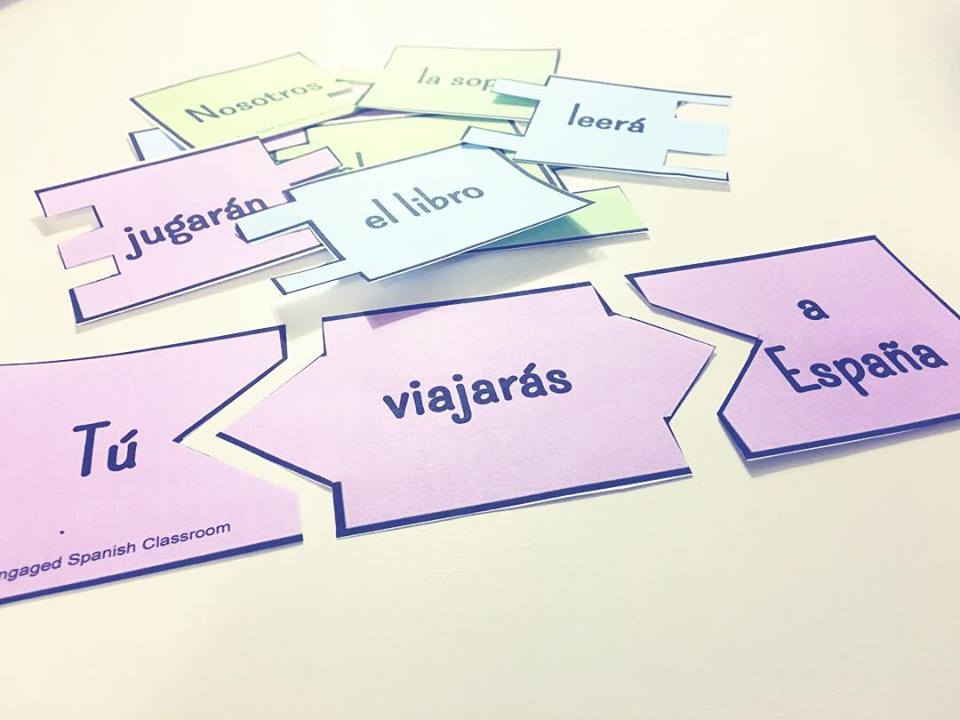I absolutely LOVE using puzzles in Spanish class. In addition to helping students build confidence, they are great for so many reasons! I love finding new ways to use puzzles with my high school Spanish students, whether it be for review, or even to introduce a brand new topic.
Read on to learn about some of my favorite strategies for using puzzles in Spanish class (and to get access to free resources!)
My go-to puzzle strategies:
- Introducing a unit
- Warm-ups
- Stations
- Races
- Take-home review
- Review before a quiz
Prep + Storage
Before we begin, I want to note that I do not prep individual puzzles for an entire class of 30 students. I do usually try to make about 20, to make sure students can choose whether they’d like to work on their own and in pairs.
Having 20 on hand also helps me to offer all of the opportunities that I do below.
To save time, I always save my puzzles from year to year. My plastic baggie system isn’t pretty but it has definitely helped me stay more organized. 20 puzzles fit very easily into a sandwich-sized baggie (I like the ones that seal closed!)
If you want to keep track of pieces, some teachers love to color code each puzzle by flipping it over and making a dot in a certain color on the other side. That way, if you find a piece on the ground, you know “Ok this comes from one of the puzzles with BLUE dots on the back.”
1) Introducing a Unit
2) Warm-ups
I tell them to choose a partner in their group and get started when they’re settled.
Often, this means that puzzles are done before the bell even rings 😉 because students are eager to sit and get it done before others in the class.
Sometimes they even try to finish it before their partner arrives… and then their partner completes it on their own as well. The change in routine and hands-on warm-up is a great way to get my students ready and focused for the day in a very short amount of time!
Want to try one of my favorite styles for free? Click below to download your own copy! And see the bottom of this post for access to MORE free resources!
3) Stations
While at this station, students race for the best time. They complete the puzzle once, and the last person to finish is “out.” They continue this until they are down to one person. If there is time, they start again. After two people have gotten “out”, it is then their job to race each other so that they are not just watching for the remaining few minutes.
My go-to puzzle style is the triangle setup, however I often use this more traditional style as well.
4) Races
You can also choose to only award the CLASS winner by keeping track of the best time in the class up on the board, and challenging the students to beat that time.
“Tim finished in 37 seconds. You guys have 5 minutes to try and beat that time. With your partner, one person times while the other person keeps track of time. Then switch. Good luck!”
My students love keeping the names and winning times on the board across all classes. They get excited to come in the next day and see “Ooh our class had the best time again!!!” It is great for boosting morale and the sense of community within the class block.
5) Take-home review
6) Review before a quiz
Want to see MORE examples before you go?
You can see all of my available puzzles here, including EDITABLE TEMPLATES so that you can create your own very easily! The templates include two designs, each with two versions ready for entering text or ready to print and make on go.
I hope these ideas help you to find new ways to use puzzles this year with your classes 🙂 Thank you for reading!













8 Comments
Thank you!! I made a puzzle after seeing one of yours on IG and it was a great activity. I love seeing all the ways you use puzzles. Planning to purchase your editable version 🙂
I'm so glad you love the idea!! The editable version comes with square and triangle options, and I love using both 🙂 There are also options to create digitally OR print and make on-the-go!
Thank you for reading!!